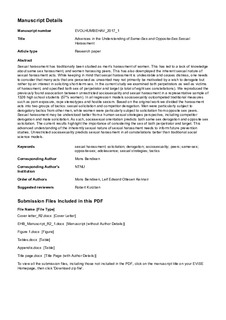| dc.contributor.author | Bendixen, Mons | |
| dc.contributor.author | Kennair, Leif Edward Ottesen | |
| dc.date.accessioned | 2017-12-07T07:25:24Z | |
| dc.date.available | 2017-12-07T07:25:24Z | |
| dc.date.created | 2017-07-15T08:45:22Z | |
| dc.date.issued | 2017 | |
| dc.identifier.citation | Evolution and human behavior. 2017, 38 (5), 583-591. | nb_NO |
| dc.identifier.issn | 1090-5138 | |
| dc.identifier.uri | http://hdl.handle.net/11250/2469456 | |
| dc.description.abstract | Sexual harassment has traditionally been studied as men's harassment of women. This has led to a lack of knowledge about same sex harassment, and women harassing peers. This has also downplayed the inherent sexual nature of sexual harassment acts. While keeping in mind that sexual harassment is undesirable and causes distress, one needs to consider that many acts that are perceived as unwanted may not primarily be motivated by a wish to derogate but rather by an interest in soliciting short-term sex. In the current study we examined both perpetrators as well as victims of harassment, and specified both sex of perpetrator and target (a total of eight sex constellations). We reproduced the previously found association between unrestricted sociosexuality and sexual harassment in a representative sample of 1326 high school students (57% women). In all regression models sociosexuality outcompeted traditional measures such as porn exposure, rape stereotypes and hostile sexism. Based on the original work we divided the harassment acts into two groups of tactics: sexual solicitation and competitor derogation. Men were particularly subject to derogatory tactics from other men, while women were particularly subject to solicitation from opposite sex peers. Sexual harassment may be understood better from a human sexual strategies perspective, including competitor derogation and mate solicitation. As such, sociosexual orientation predicts both same sex derogation and opposite sex solicitation. The current results highlight the importance of considering the sex of both perpetrator and target. This advanced understanding of the inherently sexual nature of sexual harassment needs to inform future prevention studies. Unrestricted sociosexuality predicts sexual harassment in all constellations better than traditional social science models. | nb_NO |
| dc.language.iso | eng | nb_NO |
| dc.publisher | Elsevier | nb_NO |
| dc.relation.uri | http://www.sciencedirect.com/science/article/pii/S1090513817300016?_rdoc=1&_fmt=high&_origin=gateway&_docanchor=&md5=b8429449ccfc9c30159a5f9aeaa92ffb | |
| dc.subject | Seksuell vold | nb_NO |
| dc.subject | Sexual violence | nb_NO |
| dc.subject | Evolusjonspsykologi | nb_NO |
| dc.subject | Evolutionary psychology | nb_NO |
| dc.title | Advances in the understanding of same-sex and opposite-sex sexual harassment | nb_NO |
| dc.type | Journal article | nb_NO |
| dc.description.version | submittedVersion | nb_NO |
| dc.subject.nsi | VDP::Psykologi: 260 | nb_NO |
| dc.subject.nsi | VDP::Psychology: 260 | nb_NO |
| dc.source.pagenumber | 583-591 | nb_NO |
| dc.source.volume | 38 | nb_NO |
| dc.source.journal | Evolution and human behavior | nb_NO |
| dc.source.issue | 5 | nb_NO |
| dc.identifier.doi | 10.1016/j.evolhumbehav.2017.01.001 | |
| dc.identifier.cristin | 1482314 | |
| dc.description.localcode | This is a submitted manuscript of an article published by Elsevier Ltd in Evolution and Human Behavior , 7 January 2017. | nb_NO |
| cristin.unitcode | 194,67,40,0 | |
| cristin.unitname | Institutt for psykologi | |
| cristin.ispublished | true | |
| cristin.fulltext | original | |
| cristin.fulltext | preprint | |
| cristin.qualitycode | 2 | |
